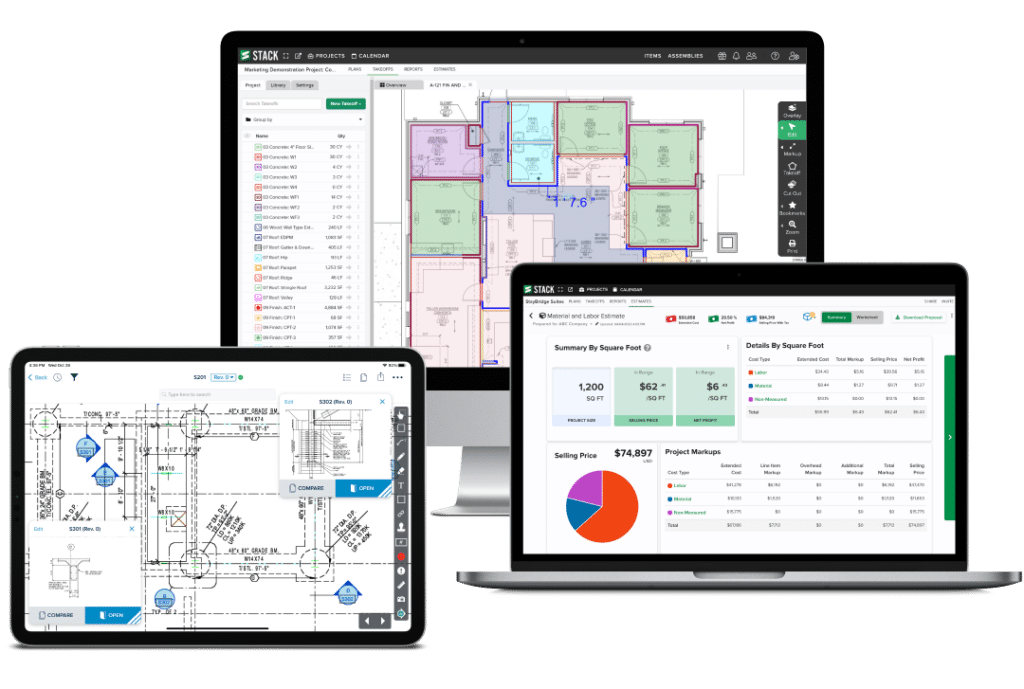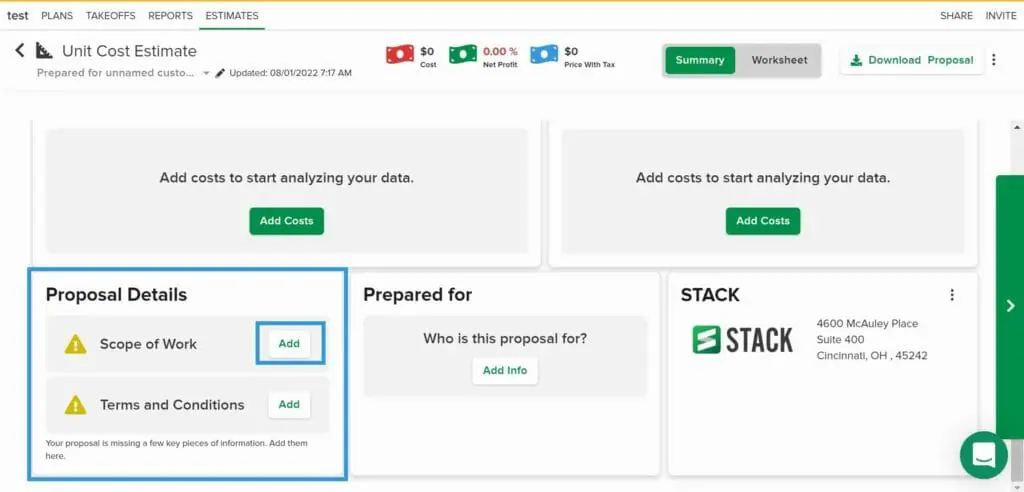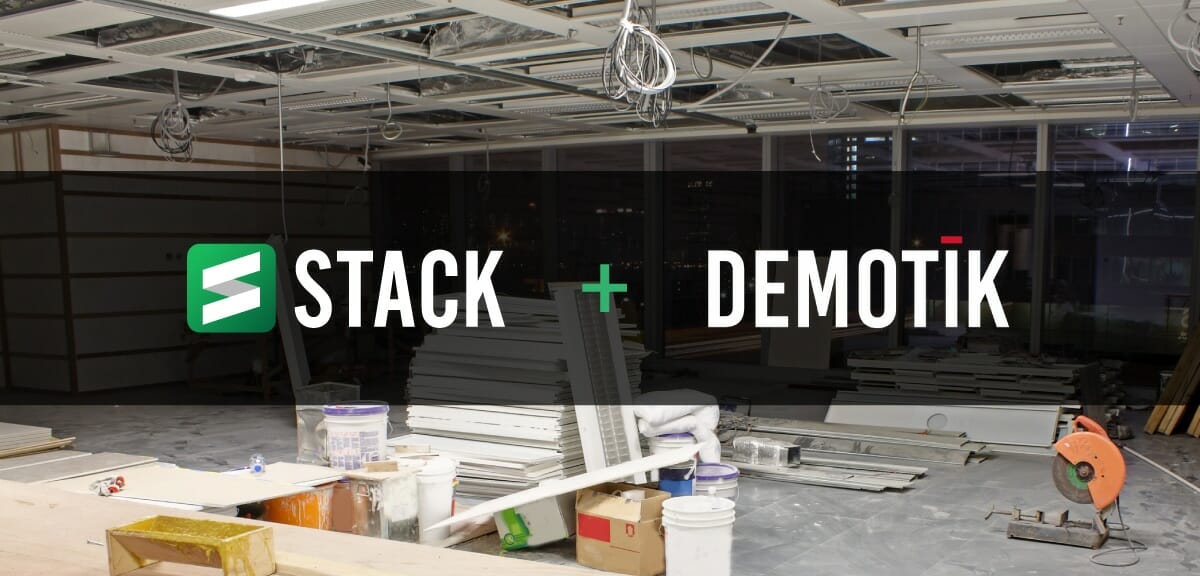Do you have seven years to spend studying for a State Bar Exam? Didn’t think so. Although legal isn’t everyone’s first language, construction contracts are critical in protecting your business from vulnerabilities. A contractor’s scope of work (SOW) sets expectations of what work will be completed and who will complete it. Without these terms, you expose yourself to litigation, payment disputes, project delays, and rework.
How do you write a concise SOW and terms and conditions in your contracts? We will help define scope of work, expose the issues with excluding legal terms, share top tips for writing a SOW, and teach you how STACK’s Takeoff and Estimating solution can help!
Bid Faster. Win More. Build Smarter.
Get your FREE account today to:
- Increase Team Efficiency
- Complete Estimates Faster
- Generate More Revenue

What Is a Construction Scope of Work and Why Clarity Is CRITICAL
A scope of work outlines the responsibilities and expectations of a construction project. A good construction scope of work will include project goals, assigned tasks, technical details, deliverables, administrative details, and a general timeline. It helps protect your profit margin by considering the details of a project before you start work. You’ll be able to create more accurate estimates, align with your team, and set expectations with the other party.
Did the agreement call for pressure-treated or untreated dimensional lumber? Was your second payment due after the foundation was poured or within 14 days of completion? Do the office walls need a level 3 or level 5 finish on the drywall? A well-written, clear scope of work will address all of these details and specific terminology. The construction industry uses a lot of different acronyms and terms for the same thing, so clarity and consistency in the SOW writing is important.
Leaving Out Legal Terms? Welcome In Legal Disputes
Without a defined and concise scope of work, there is no way to reference project goals, assigned responsibilities, and technical details. The potential for payment disputes, delays, and rework will soar. Without legal terms, you invite:
– Risk of litigation. In 2020, the average cost of construction disputes in North America was $37.9 million. You cannot over document what you do, and that begins in the preconstruction phase. The more concise your scope of work language, the better you protect your business from litigation.
– Mistakes and rework. Without clear directions on installation or detailed information on materials needed, you’re left guessing how the work will be completed. Miscommunication leads to costly rework, and confusion about who is responsible for those costs, leading to disputes.
– Scheduling disasters. Without a general timeline outlined how will you know when to line up laborers or order materials? With the current climate of supply chain issues and long lead times, you could be waiting months.
– Profit loss. All the points listed above are directly connected to losing money. If there is a scheduling delay, how will you find work while you wait for materials? Who is responsible for paying for rework if something was installed incorrectly? Leading you right into legal disputes to resolve these issues. Do you really have $37.9 million to spare?

7 Tips For Writing a Scope of Work for Contractors
Transparency is the key to writing a strong scope of work. It will set expectations of both parties involved and help mitigate risk.
1. Avoid ambiguity! Construction is full of jargon. Stay consistent with definitions and correct terminology. Some complex SOWs will include glossaries as a reference.
2. Be precise with the technical details. If specific methods or techniques are required for the completion of a task, include them in the SOW. Specifics like copper vs PVC pipes for plumbing lines, or GFCI vs standard outlets for electricians to reference are important. Visuals are also helpful, and you can include the manufacturer’s installation method instructions.
3. Include an anticipated project timeline, delivery dates, and milestones. Schedules are pretty fluid in construction, but a realistic outline is important.
4. Assign responsibilities for tasks. Detail who is in charge of what job. This is also a good place to mention what you’re NOT in charge of by adding exclusions.
5. Define the administrative procedures for the project. Include how change orders will be handled and when and how payments will be issued.
6. Define the general conditions, specifying who is responsible for things like daily clean-up, utility services, safety fences, etc.
7. Don’t forget Terms and Conditions in your contract! Include insurance clause, termination details, liability language, waivers, etc.
Create Customized Scope of Work Templates in STACK
You can easily add the scope of work and terms and conditions information to your custom proposals in STACK! In your STACK Estimate you have the ability to manually enter the information, but we suggest creating templates that you can reuse and quickly add into new proposals to apply to different types of projects.

Not much comes easy in construction, so why not make life easier by protecting your business from the start with a rock-solid scope of work. STACK is there for you every step of the process, try it for free today!








